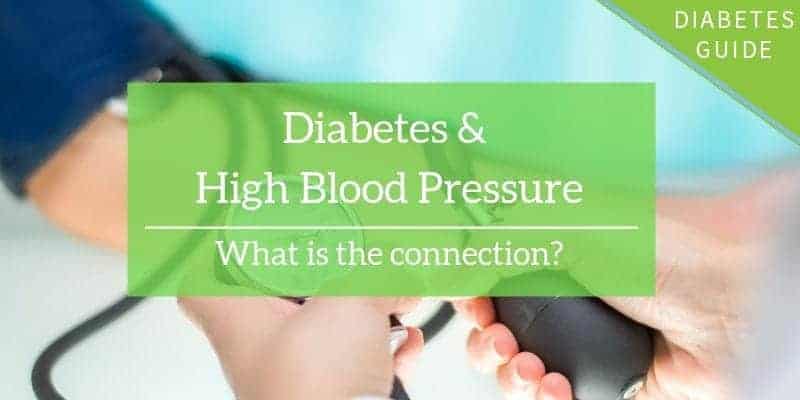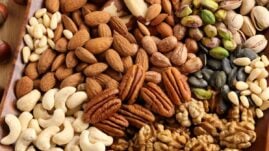This post may contain affiliate links. Please read our disclosure.
Your blood pressure is one of the most important markers of health — especially as a person with any type of diabetes.
High blood pressure (also known as “hypertension”) is very common in people with diabetes. In fact, the two conditions often go hand-in-hand because they can both result from the same lifestyle factors.
In this article, we’ll discuss what high blood pressure is and what causes it, what is a healthy blood pressure measurement, the link between diabetes and high blood pressure, and what you can do to prevent or lower high blood pressure levels.

What is high blood pressure or “hypertension”?
High blood pressure is a condition based on the force of your blood pushing against the walls of your blood vessels while that blood is being pumped and circulated throughout your body by your heart.
When the force of your blood is too high — and it qualifies as “high blood pressure” — it can put your entire wellbeing in danger.
High blood pressure severely increases your risk of:
- heart attack
- heart failure
- vision loss
- stroke
- kidney disease
- kidney failure
- sexual dysfunction
How to measure your blood pressure
Measured painlessly with a cuff attached to a small handheld pump operated by a healthcare professional using a stethoscope, your blood pressure should be measured at every check-up as a person with diabetes.
You can also get an inexpensive at-home blood pressure cuff — which is critical for those already diagnosed with high blood pressure. And you can have your blood pressure measured in free booths often located near the prescription pick-up area of your pharmacy or grocery store.
What is a healthy blood pressure level?
Your blood pressure reading is reported with two different numbers: your systolic and diastolic readings.
According to the American Heart Association, this is the difference between the two numbers:
- “Systolic blood pressure (the first number) – indicates how much pressure your blood is exerting against your artery walls when the heart beats.”
- “Diastolic blood pressure (the second number) – indicates how much pressure your blood is exerting against your artery walls while the heart is resting between beats.”
Written as 120/80 mm Hg or spoken as “120 over 80,” here are the different ranges of blood pressure readings and what they mean:
- Low blood pressure: either number lower than 90/60 mm Hg
- Normal blood pressure: at or below 120/80 mm Hg
- Hypertension stage 1: at least two readings between 130/80 and 139/89 mm Hg
- Hypertension stage 2: at least two readings above 140/90 mm Hg
- Hypertensive crisis: readings above 180/120 mm Hg
- “White coat” hypertension: For some, going to the doctor’s office is so stressful it can cause high blood pressure just during the actual appointment. If you suspect this is the case for you, you can ask to be sent home with an at-home blood pressure cuff to determine what your normal day-to-day blood pressure is like.
If you suspect your blood pressure is near or above 180/120 mm Hg, visit your nearest emergency room immediately.
What causes high blood pressure?
There are many things that can cause or increase a person’s risk of high blood pressure. It’s also important to keep in mind that sometimes high blood pressure can be the side-effect of another condition.
This means it’s critical that you are thoroughly examined and get proper bloodwork done after hypertension is identified.
Here are the most common risks and potential causes:
- Age: For those over the age of 60, your blood vessels and arteries simply become narrower and more rigid because of a lifetime’s worth of plaque build-up.
- Weight: Being overweight or obese is a significant contributor to blood pressure issues because of the stress your weight puts on your entire body, including your heart and blood vessels.
- Lack of exercise: Exercise keeps your heart healthy! Zero exercise means a weaker heart over time, increased body weight, and rising blood sugar levels.
- Diet: A diet high in salt-laden, heavily processed foods, and fatty foods will inevitably damage many parts of your health — including your blood pressure. Not eating enough potassium can also contribute to blood pressure trouble.
- Alcohol and tobacco habits: Drinking alcohol on a daily basis and smoking or chewing tobacco will wreak havoc on your entire body, including your blood pressure.
- Gender: Men tend to struggle with high blood pressure more than women.
- Pre-existing health conditions: chronic kidney disease, diabetes, heart disease, and high cholesterol.
- Family history: If your parents have high blood pressure and it isn’t directly related to any of the risk factors above, you should anticipate that you may face high blood pressures at some point, too.
- Pregnancy: Women with any type of diabetes should be highly aware of and regularly tested for pre-eclampsia. Pre-eclampsia is defined by high blood pressure during pregnancy and can be very dangerous for both mother and baby if left untreated.
Now, let’s take a closer look at the connection between high blood pressure and diabetes.
High blood pressure and diabetes
Unlike many aspects of diabetes and its connection with other conditions, there is very little mystery around its relationship with hypertension.
Differences in patients with type 1 vs. type 2
In the American Diabetes Association’s 2010 report, “Blood Pressure Management in Patients with Diabetes,” it is emphasized that hypertension is different in type 1 vs. type 2 patients.
“Individuals with type 1 diabetes usually develop hypertension because of diabetic nephropathy (kidney disease),” explains the report, “with 30 percent [of patients with type 1] eventually being affected.”
In contrast, patients with type 2 diabetes often present with hypertension either upon diagnosis of their diabetes or well before their blood sugar levels were even high in the first place. And hypertension is found in 50 to 80 percent of patients with type 2.
Where type 1 and type 2 diabetes overlap in relation to high blood pressure, however, is how it drastically increases a patient’s risk for heart disease or “cardiovascular disease.”
“With uncontrolled hypertension, there is a consistent relationship between elevated systolic BP and increased risk for micro- and macrovascular diseases,” explains the report.
More than 65 percent of the deaths in patients with diabetes are directly related to cardiovascular disease.
And for those not yet diagnosed with diabetes, it’s estimated that non-diabetic patients with high blood pressure were 2.5 times as likely to eventually develop type 2 diabetes compared to patients with normal blood pressure.
Overlapping characteristics of diabetes and high blood pressure
A 2012 study in China focused its research on how obesity, inflammation, oxidative stress, and insulin resistance in patients with type 2 diabetes may influence blood pressure levels.
The study suggests that both conditions — diabetes and hypertension — result from the onset of low-grade inflammation and that both should be considered as chronic inflammatory diseases.
“It is now realized that insulin resistance, which predicts type 2 diabetes, also has a role in the development of hypertension,” explains the study. “Indeed, hypertension and diabetes substantially share common pathways such as obesity, inflammation, oxidative stress, insulin resistance, and mental stress.”
“In reality, diabetes and hypertension are found in the same individual more often than would occur by chance,” adds the study. The researchers concluded that both conditions are often the result of genetic or environmental factors: diet, weight, tobacco use, stress, and activity level.
Exercise can play a major role in the development and treatment of both conditions.
“In the Finnish Diabetes Prevention Study, subjects with a change in moderate-to-vigorous leisure-time physical activity were 49% to 65% less likely to develop diabetes,” explains the report.
Then, in the Coronary Artery Risk Development in Young Adults study with over 15 years of follow-up, patients engaging in regular exercise saw a 17 percent reduction in their risk of high blood pressure.
In the Atherosclerosis Risk in Communities study, participants with the highest levels of activity (primarily walking and bicycling) reduced their risk of high blood pressure by 34 percent compared to the group with the lowest levels of activity.
Researchers concluded without hesitation that regular exercise has a tremendous impact on a patient’s risk of both type 2 diabetes and hypertension.
Treatment and prevention of high blood pressure in people with type 2 diabetes
The recommended treatment and steps for prevention of high blood pressure are not much different than the treatment and prevention of type 2 diabetes.
“It is well documented that lifestyle changes can lower blood pressure as much as pills can, and sometimes even more,” says Dr. Fisher from the Harvard Medical School.
Let’s take a look.
Nutrition changes
The “Dietary Approaches to Stop Hypertension” is also known as the DASH diet.
The diet itself is fairly straightforward:
- Eating vegetables, fruits, and whole grains
- Including fat-free or low-fat dairy products, fish, poultry, beans, nuts, and vegetable oils
- Limiting foods that are high in saturated fat, such as fatty meats, full-fat dairy products, and tropical oils such as coconut, palm kernel, and palm oils
- Limiting sugar-sweetened beverages and sweets
- Avoiding heavily processed salty foods
- A goal of 1,500 to 2,300 mg of sodium intake is also recommended
While some of this advice is outdated compared to the lower-carb approach to managing type 2 diabetes today, the overall point is to reduce processed sources of food and replace them with more whole foods. Yes, an avocado or a chicken thigh or an egg contain fat, but if prepared as naturally as possible, they are wonderful sources of real-food calories.
The American Heart Association also cautions patients with high blood pressure to avoid these seemingly harmless foods that actually contain large amounts of sodium:
- bread and rolls
- cold cuts and cured meats
- pizza
- poultry products
- soup
- sandwiches
Can you enjoy a slice or two of pizza sometimes? Absolutely, but it should be considered a rare choice, not a regular one.
Get moving every day
The research on the benefits of exercise for both high blood pressure and diabetes are easily conclusive. Make time for it! You can learn to enjoy exercise even if you currently think you hate it. Eventually, your body will crave it because you’ll simply feel better. But you’ve gotta get started first.
Limit your alcohol intake and ditch the cigarettes
If you’re currently drinking more than one serving of alcohol per day — or more than 7 drinks per week for women and 14 drinks per week for a man.
The American Diabetes Association recommends that people living with diabetes follow the general guidelines for alcohol consumption:
- Men: No more than 2 drinks per day on average
- Women: No more than 1 drink per day on average
Ideally, if you’re really motivated to improve your overall health, alcohol would be considered a small indulgence on the weekend versus something you consume on a daily basis. Keep in mind that alcohol is technically a poison to the body that your liver has to process to rid from your system. It will wear on every aspect of your health if consumed all too often, even 1 drink per day.
Avoid stress if possible
A stressful day here and there isn’t likely to contribute to high blood pressure. Chronic stress, however, can absolutely lead to persistently high blood pressure.
Whether it’s an overly demanding job, an unhealthy relationship, an anxiety disorder, overwhelming parenting responsibilities, and the many other ways life can take on more than we can mentally handle are all reasonable culprits of high blood pressure.
While many sources of stress may not be fully within your control, it may be time to truly consider what you can change in your life for the sake of your immediate and long-term wellbeing.
Consider medication
Like type 2 diabetes, patients taking medications for high blood pressure will likely need to use at least two different medications for significant results.
There are a tremendous number of medications available today to treat blood pressure issues, with nearly a dozen different classes of drugs to choose from:
- Diuretics: These help the body get rid of excess sodium and water, essentially by excreting more through more frequent urination.
- Beta-blockers: These work by lowering your heart rate which in turn reduces the workload on your heart and blood vessels.
- ACE inhibitors: These work by helping your blood vessels relax and open wider to create less restriction.
- Angiotensin II receptor blockers: These drugs block a chemical in the body that leads to blood vessels tightening up and becoming more restrictive.
- Calcium channel blockers: This drug prevents calcium from entering the smooth muscle cells of the heart and arteries, which helps soften and relax the intensity of your heart’s contraction.
- Alpha blockers: These drugs relax the muscle tone around your blood vessels and heart which creates less pressure and allows them to open up.
- Alpha-2 Receptor Agonists: These drugs work by relaxing your central nervous system — something that may be revving due to chronic stress in your life.
- Combined alpha and beta-blockers: These are used only in patients in a hypertensive crisis during a visit to the emergency room.
- Central agonists: These prevent your blood vessels from tensing up and contracting as much. The more relaxed these vessels are, the lower your blood pressure will be.
- Peripheral adrenergic inhibitors: Rarely used, these work by blocking neurotransmitters to and from the brain that tell your muscles to constrict.
- Vasodilators: These help your blood vessels relax and open up, creating less pressure.
If you are concerned about your own blood pressure levels, schedule an appointment with your healthcare team immediately or visit your local emergency room for more extreme cases.




Stev
In addition to DASH, exercising, …. what about other natural cures for controlling hypertension? TY
Ginger Vieira
Hi Stev,
All the healthiest habits apply when it comes to decreasing blood pressure!
Less alcohol, less processed food, more exercise, more sleep, less stress, losing weight, and less caffeine.
The simplest things for a big impact!